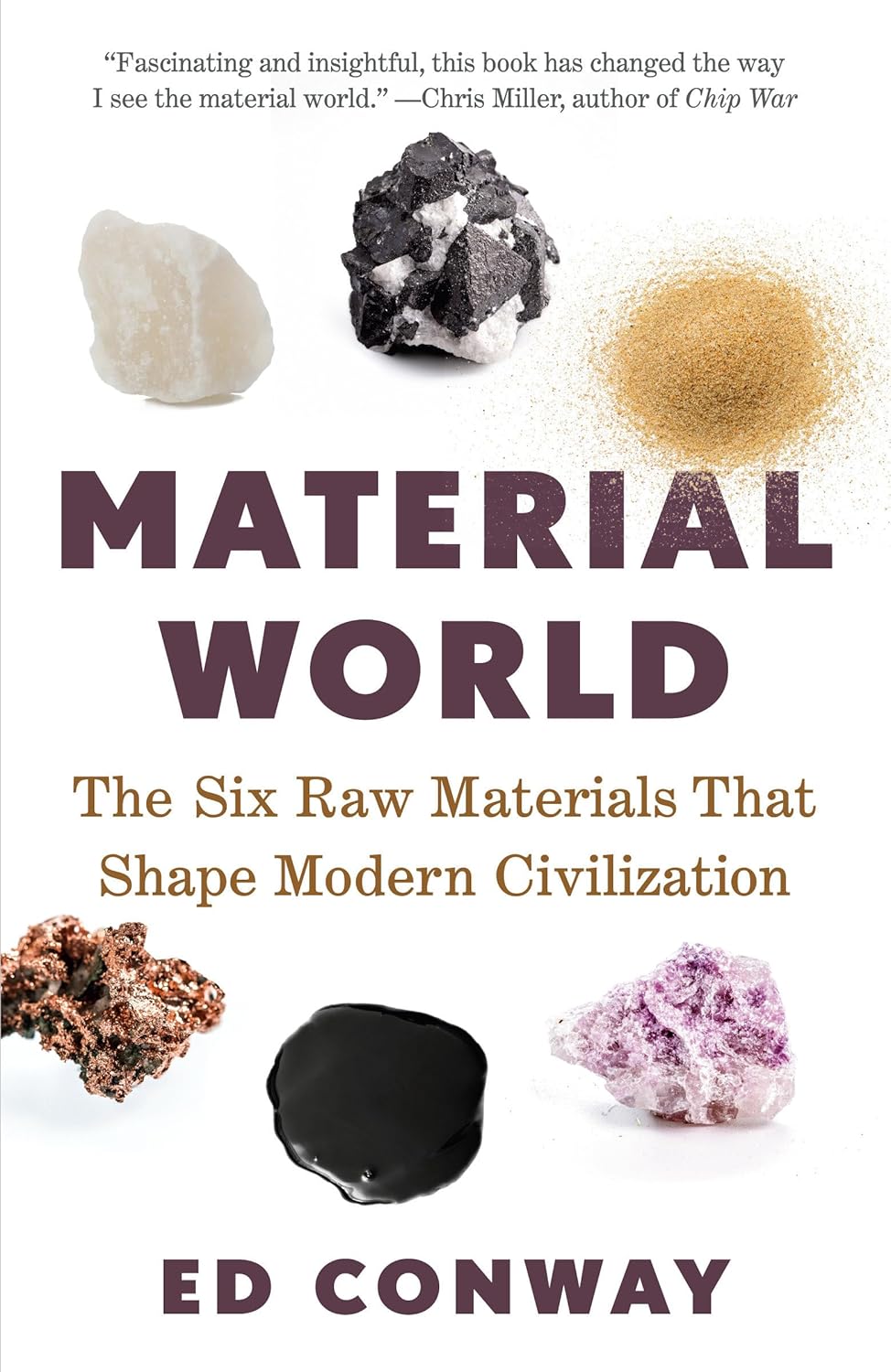I usually read 3 books at once, but my fascination with this one firmly placed my other two pending titles in the backseat. Very seldom do I find a book where north of 75% feels new and exciting. This work is absolutely fascinating.
Material World is both a celebration and a warning: a reminder that our civilization’s magic tricks are rooted in the brute force of digging, blasting, melting, and mixing a handful of substances. To build a better future, we must reckon with the true costs, ingenuity, and limits of the material world.
If you want to understand the foundations of modern life, start with sand, salt, iron, copper, oil, and lithium. They’re the unsung heroes—and villains—of our age.
1. Our Civilization Runs on Six Hidden Materials
Conway’s central thesis is simple but profound: six raw materials—sand, salt, iron, copper, oil, and lithium—are the backbone of the modern world. Forget the intangible economy of software and services; without these substances, your city, smartphone, and society itself would collapse.
- Sand forms the concrete, glass, and silicon chips that build and connect our world.
- Salt isn’t just for seasoning—it’s the chemical workhorse behind everything from soap to pharmaceuticals.
- Iron (and its alloy, steel) is the skeleton of civilization, found in buildings, infrastructure, and tools.
- Copper is civilization’s nervous system, carrying electricity through wires and enabling electrification.
- Oil is the fuel that powers transport, industry, and much of our chemical economy.
- Lithium is the “white gold” powering the battery revolution and a net-zero future.
2. The Scale of Extraction Is Staggering—and Often Unseen
We live in what Conway calls the “ethereal world,” barely noticing the mountains moved and oceans disturbed to deliver our daily conveniences. To produce a single 400-ounce gold bar, for example, requires shifting 5,000 tons of earth. The annual mass of material moved for mining, quarrying, and dredging now exceeds all the world’s natural erosion combined.
Each year, humanity extracts more from the earth than in all human history up to 1950. For every ton of fossil fuel we use, we extract six tons of other materials, mostly sand and stone.
3. Supply Chains Are Miracles of Collaboration—and Vulnerability
Conway’s detective work reveals how supply chains are so complex that no single person on earth knows how to make even a pencil from scratch, let alone a smartphone or battery. The journey of a silicon chip, for instance, involves circumnavigating the globe multiple times, from quartz mines to hyper-specialized refineries and fabs.
But these webs are fragile. The world’s supply of high-purity quartz for silicon wafers, for example, depends on a single mine in Spruce Pine, North Carolina. A single landslide could cripple global semiconductor production.
4. Our “Green” Transition Will Require More Mining Than Ever
The push for renewable energy and electrification is paradoxical: building a cleaner future means extracting more materials—especially metals—than ever before. Electric cars, wind turbines, and solar panels are much more material-intensive than their fossil-fuel counterparts. The transition away from oil and gas requires a vast increase in the mining of copper, lithium, and rare metals.
5. The True Environmental Impact Is Often Ignored
While we debate carbon footprints and GDP, the true scale of our resource extraction is hidden. Official statistics usually count only the finished materials, ignoring the mountains of “waste rock” left behind. The environmental and cultural costs, from the destruction of sacred Indigenous sites for iron and lithium, to the water depletion of salt flats—are rarely part of our calculations.
6. Scarcity Is (Usually) a Question of Ingenuity, Not Physics
Repeated predictions of “peak copper,” “peak oil,” or other resource doomsdays have been proven wrong, not because the earth is infinite, but because human ingenuity keeps finding new ways to extract, substitute, or recycle materials. The grades of copper ore keep falling, but production keeps rising thanks to technological advances.
However, this comes at ever higher environmental and social costs. As Conway notes, we’re not running out of materials; we’re running out of places we’re willing to destroy to get them.
7. Recycling and Circular Economies Are the Next Frontier, but Not a Panacea
The dream of a circular economy, where materials are endlessly reused, is still distant. For steel, recycling rates are high; for lithium, they’re under 1%. Even with perfect recycling, the growth in demand means we’ll need new mining for decades. Still, the rise of “urban mining” and battery recycling offers hope.
8. The Physical World Will Always Matter
Conway’s ultimate lesson is clear: the physical world… its rocks, minerals, and elements, remains the substrate on which all our digital dreams are built. We ignore the material world at our peril.
